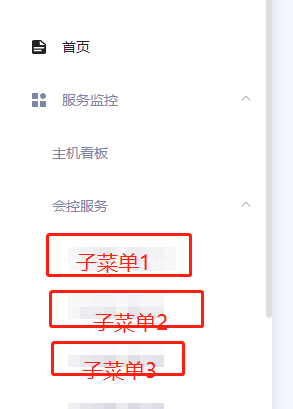JavaScript
vue动态菜单、动态路由加载以及刷新踩坑实战
需求:
从接口动态获取子菜单数据 动态加载 要求只有展开才加载子菜单数据 支持刷新,页面显示正常

思路:
一开始比较乱,思路很多。想了很多
首先路由和菜单共用一个全局route, 数据的传递也是通过store的route, 然后要考虑的俩个点就是一个就是渲染菜单和加载路由,可以在导航首位里处理路由,处理刷新。
还有一个地方就是菜单组件里展开事件里面 重新生成菜单数据,路由。大体思路差不多,做完就忘了..... 刷新的问题需要用本地缓存处理,之前一直缓存这个route 大数据,但是这个localstore 缓存的只是字符串,不能缓存对象,这样的话,菜单是出来了,动态的路由404,因为json.parse 转出来的对象 不是真实路由数据,还需要单独处理component 这个是个函数对象,
都是坑....所以之前走了点弯路,思路没想好。
第二天,重新整理思路,想了下,为啥要缓存整个route对象,傻是不是,动态的数据只是一部分,三级菜单...何不分开存储,本地存储动态菜单数据,利用完整的路由模板,取出来的初始化路由对象,然后,循环菜单数据,动态设置children属性,生成一个新的完整的路由对象,addRoute不是更好吗
想到这里,整理下完整思路
【定义全局route对象】=> 【导航首位判断刷新、初始化加载 store中route为空】=> 【初始化路由和菜单】=> 【菜单展开事件里面,请求接口,拿到子菜单数据,localStore 存储菜单数据,更新路由】
还有一些小坑 比如重复路由、刷新404问题、刷新白屏、异步处理...
教训:
问题肯定能解决,折腾几天,最后才发现思路最重要
思路错误,就是浪费时间
先想好思路,完整的实现路线 先干什么后干什么 其中遇到技术难点再去百度
分享正文:
暴力贴代码!!!!!!!!!!!!!
全局定义store route对象 都会,忽略
import Vue from 'vue'
import Router from 'vue-router'
import Layout from '@/layout'
Vue.use(Router)
export const constantRoutes = [{
path: '/login',
name: 'login',
component: () => import('@/views/login/index'),
hidden: true,
}, {
path: '/404',
name: '404',
component: () => import('@/views/error-page/404'),
hidden: true
}, {
path: '/401',
name: '401',
component: () => import('@/views/error-page/401'),
hidden: true
}, {
path: '/',
component: Layout,
redirect: '/dashboard',
children: [
{
path: 'dashboard',
component: () => import('@/views/dashboard/index'),
name: 'dashboard',
meta: { title: '首页', icon: 'documentation' }
},
{
path: 'xxx',
component: () => import('xxxxx'),
name: 'xxx',
meta: { title: 'XXX', icon: 'component' },
children: [
{
path: 'host',
name: 'host',
meta: {
title: 'xxx',
key: 'host'
}
},
{
path: 'control',
name: 'control',
alwaysShow: true,
meta: {
title: 'xxx',
key: 'control'
},
children: []
},
{
path: 'signal',
name: 'signal',
alwaysShow: true,
meta: {
title: 'xxx',
key: 'signal',
},
children: []
},
{
path: 'gateway',
name: 'gateway',
alwaysShow: true,
meta: {
title: 'xxx',
key: 'gateway'
},
children: []
}
]
},
{
path: 'meeting',
name: 'meting',
meta: { title: 'xxx', icon: 'list' }
},
{
path: 'traces',
component: () => import('@/views/xxx'),
name: 'traces',
meta: { title: 'xxx', icon: 'chart' }
}
]
},
{
path: '*',
redirect: '/404',
hidden: true
}
]
const router = new Router({
// mode: 'history', // require service support
scrollBehavior: () => ({
y: 0
}),
//routes: constantRoutes 守卫初始化,这里注释掉
})
//路由重复的问题 解决
router.$addRoutes = (params) => {
router.matcher = new Router({ // 重置路由规则
scrollBehavior: () => ({
y: 0
})
}).matcher
router.addRoutes(params) // 添加路由
}
export default router
//监听路由守卫 生成动态路由
router.beforeEach((to, from, next) => {
const routes = store.state.app.routes
console.error('beforeEach 守卫执行了')
//处理首次加载 刷新
if(routes.length === 0){
console.error('首次/刷新了')
//更新路由缓存
const cacheRoute = getLocalRouteInfo()
const routeValue = asyncRouteDataToRoute(cacheRoute.asyncRouteData, constantRoutes)
store
.dispatch('app/setRoutes', routeValue)
router.$addRoutes([...routeValue])
next({
...to,
replace: true
})
return
}
next()
})
/**
* 更新三级子菜单 路由元数据
*/
export const updateIPChildRoutes = function(routes, path, children) {
return setRouteArrayChildren(routes, path, children)
}
/**
* 根据父菜单加载子菜单
* @param {*} routeKey
* @returns
*/
export const generateIPChildRoutes = function(routeKey) {
return new Promise((resolve, reject) => {
if (!routeKey) return
// const start = getDateSeconds(new Date())
// const end = setDateSeconds(new Date(), 15, 'm')
const filterAddr = grafanaAddrs.filter(addr => addr.key === routeKey)[0]
const matchup = filterAddr.matchup
const params = {
matchup
}
//动态添加routers
try {
fetchIPInstance(params).then(ipAddrs => {
const ipRoutes = []
ipAddrs.forEach(
addr => {
const ipInstance = addr.instance.replace(/^(.*):.*$/, "$1")
if(!isIPAddress(ipInstance))
return
const existRoute = ipRoutes.find(ip => ip.meta && ip.meta.key === ipInstance)
!existRoute && ipRoutes.push(
{
path: ipInstance,
name: ipInstance,
meta: {
title: ipInstance,
key: ipInstance
}
}
)
}
)
resolve(ipRoutes)
})
} catch (error) {
reject(error)
console.error(`加载子菜单错误`)
}
})
}
import { isArray, setRouteArrayChildren } from './tool'
// 设置路由缓存值
const localRouteKey = "LOCALROUTESET";
/**
* currentPath: '' //当前访问的路由路径
* routeData: [], //存储的完整路由数据(仅加载菜单可用)
* asyncRouteData: [] //动态的路由数据(生成新路由使用)
* {
* parentKey //父级key
* route: [
* {
path: ,
name: ,
meta: {
title: ,
key:
}
}
* ]
* }
*/
export function getLocalRouteInfo() {
const data = localStorage.getItem(localRouteKey);
return data ? JSON.parse(data) : {};
}
export function setLocalRouteInfo(data) {
const localData = getLocalRouteInfo();
localStorage.setItem(
localRouteKey,
JSON.stringify({
...localData,
...data,
})
);
}
export function removeLocalRouteInfo() {
localStorage.removeItem(localRouteKey);
}
/**
* 本地缓存 转化成路由元数据
* @param {*} constantRoutes 路由模板
*/
export function asyncRouteDataToRoute(asyncRouteData, constantRoutes) {
let route = constantRoutes
if (isArray(asyncRouteData) && asyncRouteData.length > 0) {
asyncRouteData.forEach(
data => {
route = setRouteArrayChildren(route, data.parentKey, data.route)
}
)
}
return route
}
/**
* 设置路由children属性
* @param {*} routes
* @param {*} path
* @param {*} children
* @returns
*/
export const setRouteArrayChildren = function(routes, path, children) {
if (!isArray(routes) || !path)
return new Array()
for (const route of routes) {
if (isArray(route.children)) {
if (route.path === path && route.children.length === 0) {
route.children.push(...children)
} else {
setRouteArrayChildren(route.children, path, children)
}
}
}
return routes
}
onExpandMenu(key, keyPath) {
console.error(key, keyPath)
const path = key.substring(key.lastIndexOf('/') + 1)
console.error(path)
//动态生成监控三级菜单/路由
const ipAddrKeys = []
grafanaAddrs.forEach(
addr => {
if (addr.matchup) {
ipAddrKeys.push(addr.key)
}
}
)
if (path && ipAddrKeys.includes(path)) {
generateIPChildRoutes(path)
.then(ipAddrs => {
if (isArray(ipAddrs)) {
//缓存动态路由数据
const localRouteInfo = getLocalRouteInfo()
const cacheRoutes = localRouteInfo.asyncRouteData || []
cacheRoutes.push(
{
parentKey: path,
route: ipAddrs
}
)
setLocalRouteInfo({
asyncRouteData : cacheRoutes
})
//更新route
let asyncRoutes = store.state.app.routes
asyncRoutes = updateIPChildRoutes(asyncRoutes, path, ipAddrs)
store
.dispatch('app/setRoutes', asyncRoutes)
router.$addRoutes([...asyncRoutes])
}
})
}
}
其他代码 不是核心的 不贴了
总结
到此这篇关于vue动态菜单、动态路由加载以及刷新踩坑的文章就介绍到这了,更多相关vue动态菜单、动态路由加载内容请搜索 以前的文章或继续浏览下面的相关文章希望大家以后多多支持 !



